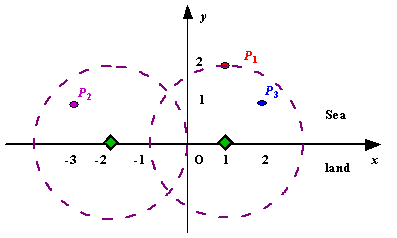【貪心】poj1328:雷達設置
阿新 • • 發佈:2018-02-07
cas bsp sep 得到 find most air seve 小數
We use Cartesian coordinate system, defining the coasting is the x-axis. The sea side is above x-axis, and the land side below. Given the position of each island in the sea, and given the distance of the coverage of the radar installation, your task is to write a program to find the minimal number of radar installations to cover all the islands. Note that the position of an island is represented by its x-y coordinates.

Figure A Sample Input of Radar Installations
The input is terminated by a line containing pair of zeros
Description
Assume the coasting is an infinite straight line. Land is in one side of coasting, sea in the other. Each small island is a point locating in the sea side. And any radar installation, locating on the coasting, can only cover d distance, so an island in the sea can be covered by a radius installation, if the distance between them is at most d.We use Cartesian coordinate system, defining the coasting is the x-axis. The sea side is above x-axis, and the land side below. Given the position of each island in the sea, and given the distance of the coverage of the radar installation, your task is to write a program to find the minimal number of radar installations to cover all the islands. Note that the position of an island is represented by its x-y coordinates.

Figure A Sample Input of Radar Installations
Input
The input consists of several test cases. The first line of each case contains two integers n (1<=n<=1000) and d, where n is the number of islands in the sea and d is the distance of coverage of the radar installation. This is followed by n lines each containing two integers representing the coordinate of the position of each island. Then a blank line follows to separate the cases.The input is terminated by a line containing pair of zeros
Output
For each test case output one line consisting of the test case number followed by the minimal number of radar installations needed. "-1" installation means no solution for that case.Sample Input
3 2 1 2 -3 1 2 1 1 2 0 2 0 0
Sample Output
Case 1: 2 Case 2: 1
解題思路:該題題意是為了求出能夠覆蓋所有島嶼的最小雷達數目,每個小島對應x軸上的一個區間,在這個區間內的任何一個點放置雷達,則可以覆蓋該小島,區間範圍的計 算用[x-sqrt(d*d-y*y),x+sqrt(d*d-y*y)];這樣,問題即轉化為已知一定數量的區間,求最小數量的點,使得每個區間內鬥至少存在一個點。每次叠代對於第一個區間,選 擇最右邊一個點, 因為它可以讓較多區間得到滿足, 如果不選擇第一個區間最右一個點(選擇前面的點), 那麽把它換成最右的點之後,以前得到滿足的區間, 現在仍然 得到滿足, 所以第一個區間的最右一個點為貪婪選擇, 選擇該點之後, 將得到滿足的區間刪掉,進行下一步叠代, 直到結束。

1 #include <iostream> 2 #include <cstring> 3 #include <cstdio> 4 #include <algorithm> 5 #include <math.h> 6 using namespace std; 7 struct node 8 { 9 double l,r; 10 }; 11 node a[1005]; 12 bool cmp(node a,node b) 13 { 14 return a.r<b.r; 15 } 16 int main() 17 { 18 int n,k=1; 19 int flag; 20 double d; 21 while(cin>>n>>d) 22 { 23 flag=1; 24 if(n==0&&d==0) 25 { 26 break; 27 } 28 double x,y; 29 for(int i=0;i<n;i++) 30 { 31 cin>>x>>y; 32 if(!flag) 33 { 34 continue; 35 } 36 if(y>d) 37 { 38 flag=0; 39 continue; 40 } 41 a[i].l=x-sqrt(d*d-y*y); 42 a[i].r=x+sqrt(d*d-y*y); 43 } 44 printf("Case %d: ", k++); 45 if(!flag) 46 { 47 printf("-1\n"); 48 continue; 49 } 50 sort(a,a+n,cmp); 51 double temp=-10000; 52 int ans=0; 53 for(int i=0;i<n;i++) 54 { 55 if(temp<a[i].l) 56 { 57 ans++; 58 temp=a[i].r; 59 } 60 } 61 cout << ans << endl; 62 } 63 64 return 0; 65 }View Code
【貪心】poj1328:雷達設置

